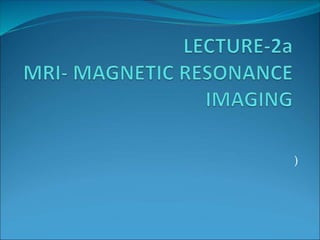
MRI Components and Procedures Explained
- 1. )
- 2. objectives MRI Introduction equipment components procedure how it helps in diagnosis
- 3. Magnetic Resonance Imaging (MRI) Pronounced (mag-NET-ik REZ-oh-nans IM-ij-ing) Defined Noninvasive scanning procedure that provides visualization of fluid, soft tissue, and bony structures without the use of radiation
- 4. INTRODUCTION Magnetic resonance imaging (MRI) has its greatest application in the fields of neuroradiology and musculoskeletal radiology. MRI uses the magnetic properties of spinning hydrogen atoms to produce images. The first step in MRI is the application of a strong, external magnetic field.
- 5. EQUIPMENT COMPONENTS AND THEIR PROCEDURE For this purpose, the patient is placed within a large powerful magnet. Most current medical MRI machines have field strengths of 1.5 or 3.0 tesla (1.5T or 3T). The hydrogen atoms within the patient align in a direction either parallel or antiparallel to the strong external field. A greater proportion aligns in the parallel direction known as longitudinal magnetization. A second magnetic field is applied at right angles to the original external field. This second magnetic field is known as the radiofrequency pulse (RF pulse) A magnetic coil, known as the RF coil, applies the RF pulse. The RF pulse causes the net magnetization vector of the hydrogen atoms to turn towards the transverse plane, i.e. a plane at right angles to the direction of the original, strong external field.
- 8. EQUIPMENT COMPONENTS Each medical MRI machine consists of a number of magnetic coils: • 1.5T or 3T superconducting magnet • Gradient coils, contained in the bore of the superconducting magnet, used to produce variations to the magnetic field that allow image formation RF coils are applied to, or around, the area of interest and are used to transmit the RF pulse and to receive the RF signal. RF coils come in varying shapes and sizes depending on the part of the body to be examined Larger coils are required for imaging the chest and abdomen, whereas smaller extremity coils are used for small parts such as the wrist or ankle.
- 9. PROCEDURE To form a magnetic resonance image, the patient is placed in a strong uniform magnetic field. The magnetic field aligns hydrogen nuclei within the patient in the direction of the field. The nuclei are “disturbed” from this orientation by application of an external radiofrequency (RF) pulse. After the RF pulse is stopped, the hydrogen nuclei return to their alignment within the externally imposed magnetic field, giving off RF signals as they lose energy. In their natural state, hydrogen atoms are spinning with their axes of rotation randomly oriented. When placed in a magnetic field, they align in a uniform direction. An RF pulse is applied, knocking the H-atoms out of their magnetic field orientation. Once the RF pulse is stopped, the atoms return to their previous alignment, giving off a signal which is then used to form the image.
- 10. •Each RF signal is analyzed by the computer for its intensity and other criteria. The signals are then assigned gray-scale values (white to black) on the detector by the computer.
- 13. PROCEDURE (cont.) There are two basic sequences in MRI that are important to understand and recognize. These sequences are known as the T1-weighted and T2-weighted sequences. The “weighting” represents the exploitation of specific properties of hydrogen atoms that are exposed to a magnetic field. T1-weighted images classically demonstrate water as hypointense (dark) and fat as hyperintense (bright), with different soft tissues expressed as a gradient in between. In T2-weighted images water is represented as hyperintense and fat as hypointense (again with soft tissues in the middle).
- 14. Bright signal on T1 spin echo - Blood - Fat including Bone marrow - Protenacious material - Melanin - Paramagnetic substances e.g. gadolinium Dark signal on T1 spin echo - Fluid - Most lesions - Metallic objects - Calcification & Air - Cortical bone SIGNAL INTENSITY
- 15. Bright signals on T2 spin echo - Subacute blood - most lesions - Fluids - Melanin Dark signals on T2 spin echo - Fat - Calcification - Chronic blood (hemosiderin) - Air
- 16. THERE ARE THREE TYPES OF MAGNETS: • Resistive Magnets • Permanent Magnets • Superconducting Magnets Resistive magnets: The resistive magnet has many coils of wire that wrap around the bore, through which electrical currents are passed, creating a magnetic field. This particular magnet requires a large amount of electricity to run, but are quite cheap to produce
- 17. Permanent Magnets: The permanent magnet is one that delivers a magnetic field, which is always on at full strength and therefore, does not require electricity. The cost to run the machine is low due to the constant magnetic force. However, the major drawback of these magnets is the weight in relation to the magnetic field they produce.
- 18. Superconducting Magnets: The superconducting magnets are very similar to the design of the resistive magnets, in that they too have coils through which electricity is passed creating a magnetic field The superconducting magnet is the most commonly used in machines today, giving the highest quality images of all three magnet types